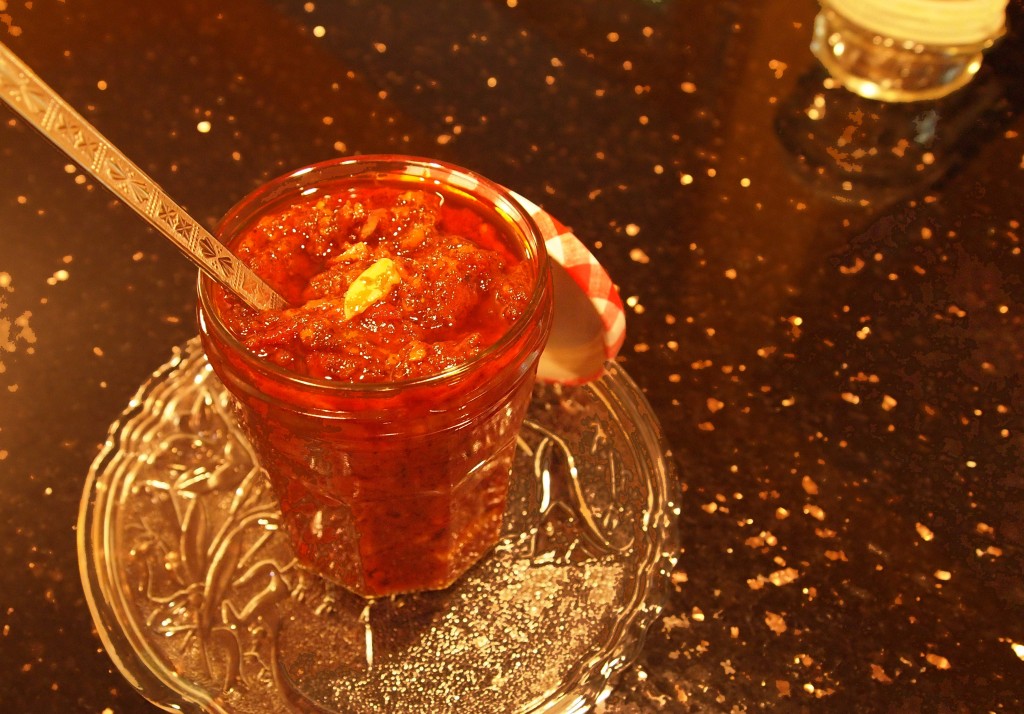
When I left my parents’ Bangalore home and moved to the US as a student, the L-shaped kitchen in a second-floor apartment on Federal Street in Philadelphia was my laboratory for one semester, and my roommate the victim of a novice’s cooking.
I did not stray much from the few main dishes I knew how to cook and was limited to the flavors of the masala (spice) powders my mother had packed for me. Nonetheless, mid-way through the semester, my roommate paid me the highest compliment I had received to date — she said my cooking reminded her of her aunt’s house in Bangalore.
Marriage and a move to Washington, D.C., brought on a clash of flavors. My spicy and savory southern Karnataka and Tamil Nadu tastes ran headlong into the sweet and nutty sensibilities of my husband’s North Karnataka cuisine.
[pullquote align=”right”]He and his brother had struggled, first to read the Kannada script of the letters, and then to recreate a sense of home in foreign kitchens.[/pullquote]For two years, with the help of recipes his mother had dictated hurriedly over the telephone or mailed in the blue aerogramme letters from India, he and his brother had struggled, first to read the Kannada script of the letters, and then to recreate a sense of home in foreign kitchens. Now a third spoke attached itself to the wheel and we plodded along as my husband and brother-in-law demonstrated their recipes and I continued to refine my own culinary abilities.
Each time my in-laws and my parents visited, however, especially after our children were born, it became obvious that we were shortchanging ourselves by not exploring the vastness of our respective cuisines beyond our few favorites. Flavorful and healthy, the recipes of my husband’s childhood had the added virtue of being simple to prepare.
Whenever my mother-in-law talked about the dishes she made, she would get a dreamy inflection in her voice as she recounted stories of her mother, Shakuntala Bai. The conversation would veer off into how Shakuntala Bai made do with so little but never let her children feel they were lacking anything. She talked of her mother’s labor of love and how her desire to cook for and feed her family shaped nearly every minute of her day, how she took into account each of her children’s likes and dislikes while planning the day’s menu, how she made sure that although their religious convictions forbade the sweets and savories found in shops and restaurants, the children were never lacking for food that touched off all their pleasure points right at home. My mother-in-law remembered helping her mother with various chores in the kitchen, along with her sisters, and learning the secrets of the flavors and techniques.
[pullquote align=”right”]She had nourished their souls.[/pullquote]It became clear that Shakuntala Bai had more than nourished her growing children’s bodies. She had nourished their souls. With my own children growing up so far away from the rest of the family, it became apparent that her recipes would eventually be lost to future generations. So in an effort to get an idea of the kind of cuisine it was, I saved those notes taken by the side of the telephone and those aerogramme letters from years ago. I made lists of the dishes I wanted to learn how to make and watched the goings-on in her kitchen during visits to India. Live demonstrations of cooking techniques and even more conversations ensued when my in-laws visited us here in the US.
If sepia tones have managed to sneak into your mind’s eye and you’re seeing glowing, soft-focus, Bollywoodesque images of beautiful kitchens in which family recipes are being handed down from one generation to the next, hold on and let’s just hit the brakes for a minute. That image of the process of inter-generational food-knowledge transfer could do with a reality check.

One day my mother-in-law made a tomato pickle that was lip-smackingly savory and delicious, to say the least. Naturally, I wanted to find out how to make it and asked. As she is wont to, she prefaced it with, “Oh, it’s so easy! All you do is…” and launched into a rapid-fire description of how to the make the dish. It didn’t have too many ingredients and there weren’t too many steps either. Just as I was thinking easy-peasy, she said, “Did I tell you about the garlic? You must add garlic. It’s very important.” The minute she said it, she saw the look on my face and we both burst out laughing.
I figured it was time I pinned down the recipes if I had to have a hope of being able to make them on my own and have them resemble the original. It was not just the specter of missing ingredients that worried me, it was also the measurements. As with all seasoned cooks, both my mother-in-law and my mother have this annoying habit of using their cupped palms and extended fingers to describe the amount of ingredients. When making the pressed rice (avalakki or poha) dishes that are so popular in North Karnataka, for instance, my mother-in-law uses one handful of pressed rice per person. It’s a trick she figured out early in her cooking life and it has worked for her unfailingly. But way back when the idea of cooking for people other than myself terrified me, this did not seem like a fail-safe instruction at all.
So I started writing down recipes — of every single dish she made — whenever I had the chance, on sheets of paper, in other cookbooks, on index cards, and in note books purchased for that purpose. And I would make notes of the substitutions I’d experimented with (such as vegetables more easily available in the US) or other changes to the method. Then my mother-in-law showed me her notebooks of recipes she had written down over the years. I jumped at the chance to finally have an exhaustive recipe resource to turn to, at least with respect to the cuisine of one half of our family tree.
And I was determined to get easily translatable measurements — not handfuls of lentils or half-a-finger length of ginger or lemon-sized balls of tamarind (which itself leads to confusion since lemons in India tend to be much smaller than the lemons in the US; anecdotes about ensuing disasters are recounted with much mirth among immigrant Indian friends).
So each time we sat down at my breakfast table I would bring out not only all our assorted notes, my computer, and pens and pencils, but also my measuring cups and spoons. One day, even a golf ball ended up on the table. My mother-in-law held up her fingers for the nth time to indicate a piece of jaggery or tamarind, I forget now, and since we had decided that ‘lemon-sized’ as an indication of the required amount was just not going to cut it, we were casting about for something more standard.
Eventually, though, the golf ball too went out the window and we resorted to the cookbook mainstays — tablespoons and teaspoons — instead. We would eye-ball the amounts that seemed right, set it out on a plate and measure each ingredient with cups and spoons, and we were on our way.
Twenty years, nearly two hundred recipes, many mundane and some epic cooking sessions later, the recipe transfer protocol is well on its way to being robust. Although the cuisine is familiar and accessible to us first generation immigrants in the family, having it all written down and organized allows our kids to pitch in and get familiar with the ingredients and techniques. Most gratifying of all, it is one more thread connecting them to the land and people of their heritage.
Sujatha Bagal is a Washington, D.C.- based freelance writer and blogger. Her essays, articles and stories have appeared in various online and print publications, including Pregnancy, Mint, ForbesLife India and The Smart Set (links are available at www.sujathabagal.com/category/












